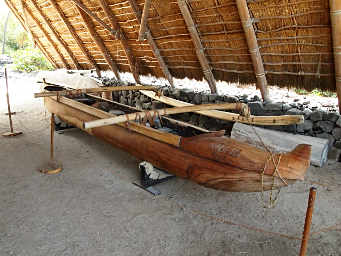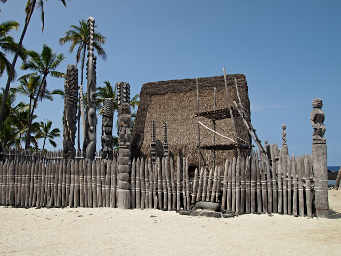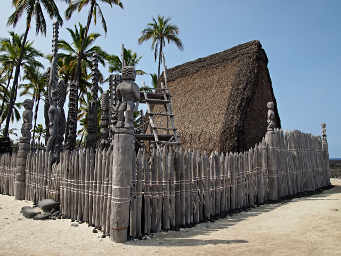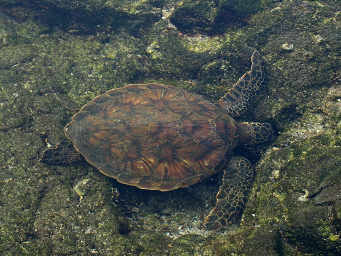Pu'uhonua O Honaunau
March, 2012
Click on any image for a bigger view
Contact me (garya at this domain) if you want the really good image
Pu'uhonua O Honaunau was another of Dona's newphew Ram's recommendations.
It's a historical park located on a small bay with good snorkeling.
There isn't much of a beach,
so if you want to lie around and sunbathe,
this isn't the place to be.
Pu'uhonua O Honaunau is a National Historical Park,
so our geezer pass got us in.
That is the best deal in the whole world,
the United States' National Parks geezer pass.
The best idea in the whole world
was the establishment of the United States' National Park System.
It is a disgrace we don't fund it better,
and some political factions keep thinking we should use them for commercial purposes.
They are a national treasure,
one we damn well better maintain for all future generations,
Americans and other world citizens alike.
Anyway, my feeble mind has already forgotten most of what we learned there.
In Hawaiian culture, there were various sacred laws with associated tabus.
I suspect many of them evolved to appease the gods
who rained down hot lava on occasion.
Or who caused children to die, or drown, or get bitten by snakes.
If you didn't understand what was going on and what caused it,
you might tend to be a wee bit superstitious.
A Pu'uhonua was a place of refuge.
If you had broken a tabu punishable by death,
your only way out was to reach a place of refuge.
If you made it,
a cleansing / appeasing ceremony would be performed
and you could return to society.
The village of Honaunau is the ancestral home of the Kamehameha line of kings.
The park contains replicas of some of the old buildings and carved statues,
and reconstructed versions of some of the original stonework.
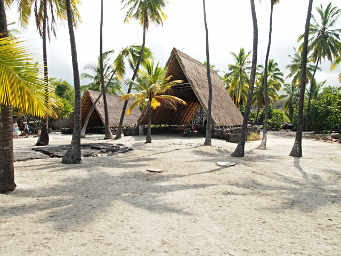 |
 |
| Canoe shed |
Lashing for roof |
One of the buildings contains some excellent outrigger canoes,
wonderful boats that are also works of art.
It would be fun to paddle one for a bit;
even take a voyage to another island.
The details of construction of these boats was great.
The sides were built up using additional planks above the hollowed out log of the main part of the canoe;
the sides were lashed in place.
Seats rested on parts of the original log left specifically for that purpose when the log was hollowed out.
 |
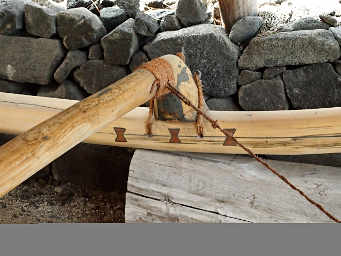 |
 |
| Outrigger detail |
Nice butterfly repair! |
Bailing scoup |
The King and his family had to be fed,
and among other things,
they maintained a fish pond.
Apparently the sea was a fickle provider.
This pond was fed by freshwater springs.
I can't remember what the circles are,
except probably spawning redds.
The refuge area was surrounded by huge walls, several meters thick.
Wow. That took a lot of rock,
and a lot of time, to build.
The rocks are all carefully fitted without any kind of mortar;
they are wonderful examples of skilled rock work.
 |
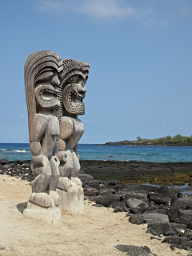 |
| Rock wall |
Ku Totem |
The bones of King Keawe-i kekahi-ali'i-o-ka-moku of Kona, King Kamehameha's great-grandfather,
were interred in a temple on a rock platform next to the Pu'uhonua.
The king's mana protected the refuge.
The structure in which the king's remains were placed became sacred.
Subsequent kings' remains were also placed there,
further increasing the spirits protecting the whole place.
| King's Sacred Resting Place |
The photo below is of a reconstructed platform,
similar to the type on which the kings' sacred temple was located.
Amazing rock work.
The Hawaiians played a game sort of like checkers,
using white and black stones placed in holes in a rock.
I guess you didn't have to worry about the wind blowing your board away and messing up your game!
 |
| Checkers like Game |
The bay is beautiful,
and the tidepools in the surrounding lava were full of fish,
coral, crabs,
and even a turtle or two!
 |
| Honaunau Bay |
 |
 |
| Trunkfish |
Hawaiian Sergeant |
 |
| Wandering Tattler |
 |
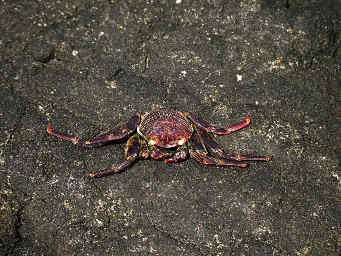 |
| Crab |
Crab Shell |
 |
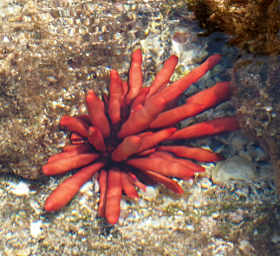 |
| Coral |
Urchin |
 |
| Sea Cucumber |
After wandering around inspecting the tidepools,
we grabbed our masks and fins
and went snorkeling.
There was a pretty good set of waves coming in,
but part of the bay was well protected and didn't have too much surge.
There was a wonderful assortment of diverse fish swimming around,
as well as turtles!
Dona got here mask clearing down,
and was a lot more comfortable than she had been in the past.
At one point we had a biggish turtle come right under us.
I had to back up -- it's eyeball was about two inches from my face.
Cool!
After a while Dona went in and I went out further
where there was a lot more surge and turmoil from waves breaking on coral close to the surface.
There were some nice coral ridges with deepish (4 m or so) "canyons" between them,
and more fish.
We saw all sorts of cool fish.
They were mostly familiar in the sense that I recognized their type
as similar to things I have seen in the Caribbean;
but they were all different, generally more colorful and with different colors in different places.
For example,
I saw a white, a yellow, and a mostly transparent trumpetfish;
whereas in the Caribbean I have only seen one kind.
We saw three or four kinds of butterflyfish,
two or three different parrotfish,
a bunch of different wrasses,
convict tang, orangebar surgeonfish,
sergeant major like things, blennys,
spotted boxfish, a blue tang-like fish,
and others.
 |
| Orchid |
I have since learned that there are some cool sea caves to the south
around the point on which the park is located.
You can kayak over to them,
and the snorkeling there is supposed to be great.
Our camp spot for the night was at the north end of the island,
and we still had some souvenir hunting to do,
so we headed on up the coast to Kialua.





